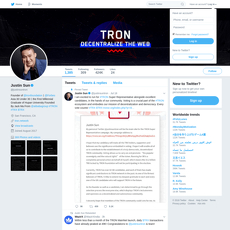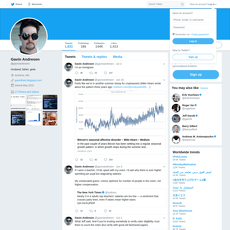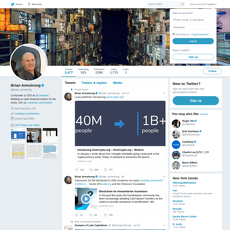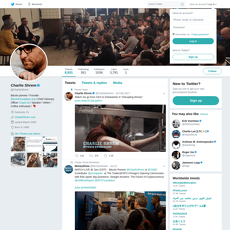Prof Emeritus Squeeze Review
Prof Emeritus Squeeze
twitter.com
Prof Emeritus Squeeze (@cryptoSqueeze) Review Guide: Everything You Need to Know + FAQ
Ever see a clean chart on Twitter, rush into the trade… and then watch price tag your entry, wick you out, and run without you? If that stung a little, keep reading.
Lots of crypto accounts post levels and “almost there” setups. Some help you plan. Others push you to chase. @cryptoSqueeze sits somewhere interesting: strong levels, clear context, and posts that feel actionable—if you know how to use them. The trick is turning his feed into your rules, not into noise that nudges you into bad timing.
Too many voices, not enough clarity
Here’s the honest pain most traders feel on X/Twitter right now:
- Signal vs noise: Great charts get buried under hot takes, copycats, and hopium.
- FOMO entries: You catch the post, miss the fill, then buy late and eat the pullback.
- Hidden risk: Levels look clean, but without invalidation you’re basically guessing.
- Impersonators: Fake accounts with paid “VIP” groups and giveaway scams are everywhere.
- Paywall traps: Teaser tweets lure you into subs without telling you how to manage downside.
Quick reality check: Retail overtrading is a documented wealth killer. One famous study by Barber & Odean found that frequent traders underperform the market by a wide margin because they chase noise and react too fast.
And it’s not just finance. Research on notification overload shows that constant alerts hurt decision quality. In crypto, that usually means buying late, selling early, and compounding small mistakes—especially when you don’t have a simple plan.
The promise
I’ll show you how to read Prof Emeritus Squeeze the way experienced traders do: as a source of levels and context you can plug into a plan. Not signals. Not FOMO fuel. A plan. You’ll get practical guardrails, a fast way to turn any of his charts into clear entries and invalidations, and quick answers to the questions everyone asks about him.
What you’ll walk away with
- A quick profile of @cryptoSqueeze and the style of analysis he shares
- Honest pros and cons so you can decide fast if his feed fits your approach
- A simple framework to action his ideas without overtrading or guessing
- FAQs people actually search—legitimacy, timeframes, alerts, paid groups
- Helpful resources and links you can bookmark and use right away
Bookmark the live version of this review on cryptolinks.com so you can reference it before you trade.
Real example of the problem: You see a S/R flip chart of BTC at range high. The tweet highlights a clean breakout level but doesn’t spell out invalidation. You buy on the first poke through. Price wicks above, fails back into the range, and you’re stuck debating whether to “give it room.” That’s not a chart issue—that’s a process issue. The fix is simple: translate public levels into rules before you click buy or sell.
Coming up next: Who is Prof Emeritus Squeeze and what does he actually post—levels, timeframes, and how to read his caution vs conviction. Want the quick tells that separate “interesting chart” from “tradable setup”? Let’s get that on your screen next.
Who is Prof Emeritus Squeeze and what does he actually post?
Think of @cryptoSqueeze as a level-first market reader. He keeps things grounded in structure: where price is accepted, where it’s rejected, and what must happen next for a trade to make sense. You’ll see him speak in “if/then” terms, not certainties—because the market doesn’t owe anyone straight lines.
“Plan the trade, trade the plan. Levels before leverage.”
His feed centers on three pillars:
- Market structure: ranges, breakouts/deviations, reclaim/loss thresholds, and prior highs/lows that matter.
- Key levels: horizontal support/resistance and mid-range anchors that define risk. You’ll often get the “do nothing in the middle” nudge.
- Momentum context: whether impulse is building or stalling, often tied to 1H–1D closes and how price behaves around a boundary (acceptance vs. rejection).
Focus-wise, expect heavy attention on majors like BTC and ETH, with high-beta names sprinkled in when liquidity and momentum line up. Timeframes commonly orbit the 1H/4H/D for directional bias, with notes when lower timeframes are noisy or when higher timeframe levels trump everything else.
What stands out is the emphasis on invalidation. You’ll usually get a clear “wrong below/above here” line. That’s not just style—it’s the backbone of surviving in crypto. Loss aversion pushes traders to “hope” rather than cut, and having pre-committed invalidations helps keep you honest (see Prospect Theory). Pair that with the reality that overtrading kills performance (Barber & Odean), and you’ll see why his posts nudge you toward patience over impulse.
Posting style and focus areas
Here’s what you’ll typically see as you scroll his feed:
- Chart snapshots: clean levels marked, minimal clutter. Horizontal SR and range boundaries do most of the heavy lifting.
- Level-based setups: reclaim/loss triggers, sweeps, and “acceptance” language. The idea is simple: earn your bias by what price does at the level.
- Trend context: notes on the higher timeframe bias so you don’t scalp long into a daily downtrend or short into a weekly uptrend.
- Macro and event awareness: reminders around CPI/FOMC, ETF headlines, or funding/oi extremes—windows where levels matter, but timing can get violent.
- Teaching tone: he’ll often include “no trade in the middle” or “wait for close” guidance—tiny lines that save accounts.
Sample of what a typical post might look like (not a live call, just the style):
- “BTC 4H: Reclaim 68k → 70.5–71.2k. Lose 66.4k → 64.8k sweep likely. Invalidation if 4H closes back inside 67.2–67.5k range mid.”
- “ETH: No trade in the middle. Acceptance above prior high opens expansion. Failure → deviation and rotate back to mid.”
That structure-first language helps you decide quickly: trade, wait, or walk away.
Frequency and timing
Cadence adapts to the tape:
- Fast markets (breakouts/liquidations): expect tighter invalidations, more “wait for close” caveats, and quicker follow-ups when levels flip or fail.
- Quiet ranges: fewer posts, more reminders to let levels come to you, and clarity on which boundaries really matter.
- Event windows: emphasis on risk—“don’t get chopped front-running CPI/FOMC” energy—because one print can invalidate a perfect-looking micro setup.
Updates matter most when price is hugging a boundary. If he’s circling a reclaim level for days, that’s the one to alert. When price is in the mushy middle, you’ll often see him downshift the urgency and signal patience.
How he communicates setups
He tends to mark the trade like a checklist:
- Entry idea: often phrased as an if/then trigger—reclaim/loss, sweep-and-reclaim, acceptance above/below a line. Example: “Reclaim 188 on SOL 4H close → momentum into 198/204.”
- Invalidation: a single line that kills the idea. Example: “Invalid below 184 on a closing basis.” This keeps you from marrying the bias.
- Targets (when provided): prior highs/lows, mid-range, and measured legs. Sometimes it’s a zone rather than a tick-perfect take-profit.
- Caution language: “no trade in the middle,” “let it confirm,” “failed breakout = deviation” are all red lights against FOMO.
Here’s a realistic, compressed walk-through of how one of his charts reads in practice:
- Bias: SOL is range-bound 165–188 on the 4H. Broader trend constructive while 165 holds.
- Trigger: 4H reclaim and hold above 188 signals range expansion.
- Invalidation: back inside 186–187 on a 4H close = idea is wrong; avoid chop.
- Targets: 198 first trouble area, 204 extension if momentum persists.
- No-trade condition: stuck 176–184 with no acceptance; wait for either boundary.
This style compresses thinking time. You either have the reclaim and take it with defined risk, or you don’t. No guessing. And that’s the emotional edge—less “I hope,” more “I know where I’m wrong.”
One last note: he frequently insists on confirmation via candle closes rather than wicks. In crypto, where wicks are designed to test your nerve, waiting for acceptance helps filter noise. Yes, it means missing a few rocket starts. It also means avoiding a lot of fake-outs, which, if you’ve ever watched a perfect breakout nuke back into range, you know is priceless.
If that sounds refreshingly practical, you’ll probably click with him. But is it all upside? Where does this style shine, and where can it catch you off guard? I’ll break down the real strengths—and the red flags you won’t see on a glowing thread—next.
Strengths and red flags: my honest review
What I like
I track a lot of crypto Twitter accounts, and this one stands out for turning chaos into clean lines. When he’s on, you get levels that make you pause, plan, and wait. That alone can save you from self-inflicted losses.
- Clear levels that cut through the noise. You’ll often see simple, high‑signal marks like “range high,” “acceptance above,” or “failed breakout.” Example: a BTC chart with a range top around 71.8k and invalidation back inside 70.9k (numbers illustrative). That makes it easy to set alerts and avoid forcing entries mid-candle.
- Scenarios, not certainties. The if/then framing (“accept above X → target Y; lose X → back to Z”) nudges you to think in branches. That mindset reduces FOMO and aligns with what behavioral research calls “pre-mortem planning,” which helps curb impulsive risk-taking.
- Invalidation-first DNA. When invalidation is marked, it’s usually crisp. That’s gold for defining risk. If your stop is obvious, your size can be rational. If it’s vague, you’re basically gambling.
- Teachable phrasing. Short blurbs like “deviation then reclaim,” “liquidity sweep,” or “acceptance” give you language that maps to repeatable setups. It’s not just a call; it’s a concept you can reuse.
- Volatility awareness. Flagging CPI/FOMC windows or “headline risk” helps you avoid the classic mistake: entering 3 minutes before a data print. There’s plenty of evidence that macro news spikes crypto volatility—see studies on Bitcoin’s sensitivity to macro announcements on SSRN.
“Clarity beats urgency. If the setup is real, the market will give you another entry.”
That’s the emotional unlock here—steadier posture, fewer revenge trades, and more respect for invalidations.
What to watch out for
This is where most people get burned. Great charts don’t protect you from bad execution. Tweets are snapshots, not signals.
- Tweets aren’t trade signals. A posted level isn’t a trigger. Without a defined entry method (break-and-hold, retest, acceptance on close), you’ll likely chase and eat slippage. Overtrading kills—classic research shows higher turnover typically leads to worse returns (Barber & Odean).
- Lag in fast conditions. If BTC rips 2% in five minutes, the update you’re reading might already be “post-event.” If you arrive late to a breakout and skip the retest, you’re volunteering as exit liquidity. A common trap: ETH clears a 4H level, you market buy, it wicks back inside, you’re trapped.
- Context matters—hard. The same 4H breakout behaves differently inside a weekly downtrend versus a weekly accumulation. If you don’t map his level onto the higher timeframe, your win rate will suffer.
- Confirmation bias is real. When you want a long, you’ll see any green arrow as “proof.” Fix this by pre-writing your invalidation before you open the chart. Humans are wired to seek confirming info; it’s a well-documented bias in behavioral research.
- News-adjacent breakouts are tricky. CPI/ETF headlines create fast fakeouts. Even strong levels get run. If price is already extended into resistance minutes before a print, that’s usually a “no trade.” Wait for acceptance after the dust settles.
- Copycats and impersonators. There are lookalike handles and quote-farms. The only real profile is @cryptoSqueeze. Don’t trust DMs, “giveaways,” or anyone asking for funds. Check handle spelling, post history, and chart style. Blue checks are not enough.
Transparency and track record
No free account is perfect. What matters is consistency, clear invalidations, and whether misses are acknowledged. Here’s how I sanity-check any analyst’s feed—quickly.
- Look for idea follow‑ups. If a level breaks, is “invalidated” or “back inside” stated? You don’t need a post to exit, but a habit of acknowledging misses says a lot about reliability.
- Audit 30 days yourself. Scroll the timeline, collect 10 setups with levels and invalidations, and note outcomes versus those invalidations. You’re not grading PnL; you’re grading process. Did the market respect the map? Did the account stay consistent?
- Time‑stamped clarity. Use Twitter’s advanced search (example: from:cryptoSqueeze BTC since:2025-08-01) to see how levels evolved. Save screenshots so you can compare before vs. after without hindsight tricks.
- Beware selective memory. Crypto Twitter loves victory laps. You want someone who can post a clean line and then accept when it breaks. Survivorship bias will fool you if you’re not keeping notes.
- Verification checks. Real handle: @cryptoSqueeze. Watch for micro-typos like @cryptoSqueeeze, sudden “promo” posts, or anything asking for wallet connects. If it smells off, it is.
Bottom line on strengths vs. red flags: the value is there if you use the feed to structure your own plan, not to outsource it. Want the exact 5‑minute checklist I use to turn one of his charts into a trade with entry, invalidation, targets, and a “no‑trade‑if” rule? Keep going—next up I’ll map it step by step so you don’t chase another breakout you can’t manage.
How to use Squeeze’s insights without wrecking your account
Great charts don’t save accounts—rules do. If you like @cryptoSqueeze’s clean levels and structure, here’s how I turn a single post into a calm, repeatable plan in under five minutes.
“Plan the trade. Trade the plan.” It’s not poetry—it’s a survival skill.
Turn tweets into a plan
I use a simple template. If a tweet can’t fill these blanks, I skip it:
- Entry idea: What must price do to validate the setup? (break/reclaim/reject/close)
- Invalidation: The exact price or condition that kills the idea
- Target(s): Logical levels to take profit (prior highs/lows, range mid, measured move)
- Position size: How much I can risk to invalidation (fixed % of equity)
- No-trade-if: Conditions that make me stand down (news window, wick city, thin books)
Example (hypothetical from a typical Squeeze-style 4H chart):
- Asset: BTCUSD
- Key level: 63,800 (4H level)
- Entry idea: 4H close above 63,800 + hold the retest → long
- Invalidation: 4H close back below 63,800 or a wick-through with heavy volume and no reclaim
- Targets: 66,200 (range mid), 67,500 (prior supply)
- Position size: Risk 0.5% of equity to the stop
- No-trade-if: FOMC/CPI within 60 minutes, or the break happens on a single vertical candle >2x 14-period ATR
Math that keeps me honest: Expectancy = (Win% × Avg Win) − (Loss% × Avg Loss). With a 40% win rate and 2R average winners: 0.4 × 2 − 0.6 × 1 = +0.2R. You don’t need to be “right” often—just structured.
Timeframes and context
He often posts higher-timeframe levels. Use them as the map, not the car. Match his timeframe to your trade horizon:
- Daily/4H idea → swing or position trade. Stops and targets wider. Lower frequency, higher conviction.
- 1H idea → intraday swing. Fewer trades, enough room for noise.
- Don’t use a 4H bias for a 1-minute scalp. That’s how you turn structure into chaos.
Regime check (60 seconds):
- Trending: Higher-highs/higher-lows; 20/50/200 EMAs aligned; range breaks hold. Favor breakouts/retests.
- Ranging: Clear highs/lows; mid-line respect; ATR contracting. Fade edges, respect mid.
- Chop: Mixed highs/lows; fakeouts; EMAs intertwined. Sit out or reduce size. Patience > bravado.
Sample translation: If he marks a 1D range 60k–72k and price is at 71.5k, a “reclaim 72k” note means I wait for a 4H close above 72k and a stable retest. If price hovers mid-range (66k), I usually do nothing. Mid is where accounts go to die.
Alerts and organization
Remove guesswork before the move starts:
- Chart alerts: On TradingView, set alerts at his levels with “close” conditions, not “touch.” Add ATR filters in your head: a single spike isn’t a real break.
- Social alerts: Use a Twitter List with notifications for @cryptoSqueeze so big updates don’t get buried.
- OCO orders: One-Cancels-the-Other brackets for target and stop. Automation beats adrenaline.
- Journal one-pager: “Why this level? What kills the idea? Where is 1R/2R? What would I tell a friend?” If I can’t answer in a minute, I skip.
Checklists work. In medicine, simple checklists cut major complications by ~36% (WHO/Atul Gawande). Trading isn’t surgery—but the error types are the same: rushing, skipping steps, ignoring alarms. A 20-second checklist can save a month of PnL.
Risk guardrails
Survival rules I don’t break:
- Fixed risk per trade: 0.25%–1% of equity. Position size = (Account × Risk%) / (Entry − Invalidation). Example: $10,000 account, 0.5% risk ($50). Entry 63,800, stop 63,000 → distance $800 → size ≈ 0.0625 BTC. Leverage only to meet margin, never to increase risk to stop.
- Hard stops, not “mental.” “Your first loss is your best loss.” I’d rather be out and wrong than in and hoping.
- No doubling down. If invalidated, I’m done. If it re-sets up, it’s a new trade with fresh risk, not a grudge.
- Daily loss cap: 2R or 2%—whichever comes first. Hit it? I walk. Barber & Odean’s research showed over-trading crushes returns; stopping rules protect me from myself.
- Correlation trap: BTC + ETH + SOL on the same thesis = one trade in three coats. I split risk across the basket; I don’t triple it.
- News filter: 30–60 minutes before/after major events (CPI, FOMC), I reduce size or pass entirely. Good levels fail in bad liquidity.
- Pre-mortem: “It’s tomorrow and this trade lost. Why?” Slippage, spread, fakeout close, hidden news. If the list is long, I size down or skip.
One more emotional guardrail: I ask, “Would I post this plan publicly before taking it?” If the answer is no, I’m probably forcing it. As Warren Buffett says, “The stock market is a device for transferring money from the impatient to the patient.” Crypto is that on fast-forward.
If you’re wondering how reliable @cryptoSqueeze is, whether he shares invalidations and targets consistently, or if there’s a paid group behind the curtain—want the straight, no-fluff answers? Keep going; I answer those exact questions next.
FAQ: Quick answers people ask about Prof Emeritus Squeeze
I’m keeping this fast, practical, and based on what matters when you’re trying to turn a tweet into a clean trade plan—without falling for impersonators or chasing candles.
“Amateurs chase calls. Pros track levels.”
The short answers to popular questions
- Is @cryptoSqueeze legit? Yes, the real account posts consistent level-based charts and market context. Treat posts as ideas, not signals. If anyone DMs you “investment opportunities,” it’s a scam.
- Does he give clear invalidations? Often. You’ll see lines or zones that function as invalidation. If you can’t spot where you’re wrong within 5 seconds, you don’t have a setup—move on.
- Are there targets? Sometimes explicit, often implied (prior swing highs/lows, range mid, liquidity pools). When in doubt, map 1R, 2R, and key structure levels yourself.
- Does he run paid channels? If anything paid exists, it will be announced publicly on his real profile. He’s not DMing you. No WhatsApp, no “private deal,” no wallet addresses. Zero exceptions.
- What markets/timeframes? Primarily BTC and majors, with occasional narrative coins. Timeframes tend to be 1H–4H and Daily; intraday notes appear around volatility events (CPI, FOMC, ETF flows).
- Can I copy-trade his tweets? You can try, but it’s risky. Latency, spreads, and your execution discipline matter. As Barber & Odean’s classic research showed, overactive traders often underperform—process beats impulse.
- How do I avoid impersonators? Match the exact handle @cryptoSqueeze, review post history, check replies from known accounts, and never engage with DMs asking for money. Scammers often use extra letters/underscores.
- How do I set alerts for his levels? Mark his level on your chart and set an alert for “Crossing” or “Crossing Up/Down.” Pair that with notifications from his account for major updates.
- What’s his “strategy” in one line? Level-led trading: identify key support/resistance, define invalidation, wait for trigger, manage risk hard. It’s not magic—it's structure and discipline.
- Is he accurate? Plenty of good reads, and some misses like anyone else. What stands out is the structure: where you’re right, where you’re wrong, and when to stand down. That’s what you can actually use.
Quick context that helps: Planning beats impulse. Multiple studies in behavioral finance show that pre-committing to exit points and position sizing reduces emotional errors. Think Kahneman’s “System 2” planning over “System 1” reacting, and Barber & Odean’s work on overtrading hurting returns.
Topics covered
- Is @cryptoSqueeze reliable?
- Does he share invalidations and targets?
- Does he run paid channels or private groups?
- Which markets and timeframes does he focus on?
- How do I avoid impersonators and scams?
- How to set up alerts to track his levels?
Example: decoding one of his charts
Here’s how I’d read a typical Squeeze post and turn it into a clean, executable plan in under a minute.
- Bias: He marks BTC with a range 66.2k–68.9k, noting “acceptance above 68.9k opens 69.8k/71k.” That’s a range with a breakout idea.
- Invalidation: A red line sits at 67.6k (last higher low). If price closes below 67.6k after a breakout attempt, the idea is likely wrong for now.
- Trigger: “Acceptance” usually means a close above the level on his chart timeframe (for 1H/4H charts, use that close). Not just a wick; an actual close with follow-through.
- Entry plan:
- Option A: Breakout-close above 68.9k, enter on minor pullback to 68.9k–69.1k.
- Option B: If price rejects above 68.9k and re-enters the range, consider a fade back to mid (only if that’s your style and you accept faster invalidations).
- Targets: First target prior high at ~69.8k, second at 71k. Trail stops under higher lows as structure builds.
- Position size: Risk first, size second. If entry is 69.0k and invalidation is 67.6k, risk distance = 1.4k. If I risk 1% of my account, position size ≈ 1% / (1.4k / entry). On a $10,000 account and BTC at $69,000, 1% = $100; $100 / (1,400/69,000) ≈ 4.93% notional of account (adjust for your venue and fees). Simpler: pick contracts/size so a stop at 67.6k costs $100 max.
- No-trade-if: Wick above 68.9k but close back below on the same timeframe with weak volume—skip. If news hits and volatility spikes beyond your stop tolerance, skip.
Three things I always check against his post:
- Timeframe alignment: If his idea is on 4H, I don’t scalp it on 1m.
- Regime: Trend day vs choppy range. In ranges, take profits faster; in trends, let partials run.
- One-cancel-other: If I plan both breakout and fade scenarios, I only keep one live at a time to avoid accidental hedging or doubling risk.
Pro tip: set two alerts before you do anything—one at the trigger level, one at invalidation. This cuts snap decisions. Traders who reduce impulsive entries tend to preserve more capital, which compounds better over time.
Emotional check-in: If you feel your heart rate spike when price gets near the level, step back. A level should make you calm because you know exactly what to do if it hits—and exactly what to do if it fails.
Want the exact places to follow the real account and the tools that make this workflow frictionless? That’s next. Ready for the official links and a short stack of resources that pair perfectly with his style?
Helpful resources, links, and alternatives I trust
Official links and verification
The only account I track is here: https://twitter.com/cryptoSqueeze. Bookmark that exact URL and use it as your launchpad.
How I confirm authenticity in 10 seconds:
- Open the profile from your bookmark, not from a search result or a random mention.
- Scan the handle carefully: impersonators love lookalikes like “crypt0Squeeze” (zero), extra underscores, or swapped letters.
- Check the history: real, consistent posts over months/years, not a sudden flurry of charts and giveaways.
- Refuse DMs: don’t send money, don’t “connect wallet,” and don’t click “private group” links. Public feeds are public for a reason.
- Cross-verify via quotes: legit accounts are regularly quoted by known traders you already trust.
Rule I live by:“If it starts with a DM, it ends with regret.” Keep everything on the timeline and in your terminal.
Tools that pair well
I like to pair level-based context with three layers: charts/alerts, order flow + liquidity, and event awareness. This way, I’m never blind to a key level, a sudden liquidity shift, or a calendar landmine.
Charts and alerts
- TradingView — clean charts, easy alerts. I set horizontal line alerts exactly at the levels he highlights, and I use “once per bar close” when I only want confirmation, not noise.
- Fast setup example: draw a line at a posted level (say, 48,200), right-click → Add alert → select Crossing → choose Once per bar close on the 1H/4H to reduce false pings. Add a note: “Wait for close above + OI not spiking”.
- Bonus: Use webhook alerts (TradingView → Discord/Telegram) so you never miss key moves during work hours.
Order flow, liquidity maps, and positioning
- TradingLite or TensorCharts — heatmaps to spot resting liquidity near his levels. If a ceiling disappears right before a breakout, I proceed with caution.
- Bookmap or ExoCharts — footprint and delta for “is this move being hit with aggression?” Useful for avoiding paper-thin breakouts.
- Coinalyze and Coinglass — open interest, funding, liquidation heatmaps. If OI balloons into resistance with funding perked up, I lean defensive on “first touch” longs.
- Laevitas and Deribit Insights — options skew and implied vol help me avoid piling in ahead of an IV crush (classic post-event rug).
News, event risk, and macro context
- Forex Factory Calendar or Investing.com Economic Calendar — set alerts for CPI, FOMC, NFP, PCE. These are the usual volatility bombs.
- CME FedWatch — tracks rate expectations. Big repricings often front-run your levels.
- Farside Bitcoin ETF Flows — I watch flows on big trend days; strong inflows can support level breaks, while outflows can sap momentum.
- Whale Alert — not a signal, but if a cluster of large transfers lines up with your alert, think twice about fading.
Workflow and organization
- Twitter Lists or X Notifications — I keep a “Levels + Macro” list so key posts don’t get buried.
- Notion or Google Sheets — one-page journal: setup, level, invalidation, why it fits, result. If I can’t summarize the idea in 3 lines, I skip it.
Why bother with this stack? Because it reduces overtrading and “attention-chasing.” There’s solid research showing that retail traders tend to trade too much and chase what’s in front of their eyes:
- Barber & Odean (2000), “Trading Is Hazardous to Your Wealth” — SSRN
- Barber & Odean (2008), “All That Glitters: The Effect of Attention and News...” — RFS
Alerts at pre-defined levels and an event calendar are simple ways to counter those biases.
More reading and resources
Want to cross-check levels, improve execution, and keep your plan tight? I keep a short list of references and tools I revisit when the market gets noisy:
A quick mental model I use:
“If the level matters, price will come back to it. Missing is better than messing.”
Set the alerts, let the market come to you, and be ready with your invalidation. Easy to say, harder to practice — but it’s how you keep your edge.
Curious whether this approach makes him worth your attention and who will benefit the most from following? I’m about to answer that next — and I won’t sugarcoat it. Ready for the verdict?
Final verdict: Is Prof Emeritus Squeeze worth your attention?
Yes — with a plan. If you treat his posts as structured ideas and not trade signals, you’ll likely get real value. He’s strongest when you use his levels to frame scenarios, set alerts, and wait for your trigger — not when you chase a candle because a tweet looks clean.
Simple rule: “If price reclaims X on volume, I’ll take the trade. If it loses Y, I’m out. If neither, I’m flat.” That’s how to read his posts and stay sane.
Quick example of how I use a typical post: if he marks something like “BTC holding 64.3k; reclaim over 64.9k opens 66.2k; invalid below 63.8k,” I’ll do three things:
- Set alerts at 64.9k and 63.8k (not market-buying into chop).
- Pre-commit size and exit: risk 0.25–0.5% per idea, stop under 63.8k, scale out near 66.2k.
- Skip if conditions aren’t met within my session or if news risk spikes.
That single shift — from “nice chart” to “if-then plan” — is the difference between stress and consistency.
Who will get the most value
- Level-first thinkers: You like clean invalidations and you’re okay with, “No trade is a position.”
- Swing and day traders who wait for confirmation rather than guessing tops and bottoms.
- Builders of discipline: You’re willing to pair his posts with small size, alerts, and a checklist.
- People who review their own work: You’ll journal what you planned vs. what you did, then adjust.
Who won’t: anyone looking for spoon-fed entries/exits, or traders who ignore invalidations and average into losers. Public Twitter won’t do your risk management for you.
If you want to go further
- Follow the real account and turn on notifications for meaningful updates: twitter.com/cryptoSqueeze.
- Run a 90-second plan per idea:
- Bias: up, down, or neutral?
- Trigger: the reclaim/break he’s watching.
- Invalidation: the line that proves you wrong.
- Risk: fixed % of equity (I keep it 0.25–0.5%).
- Targets: first area to pay yourself; remainder trails or exits on structure loss.
- No-trade conditions: low volume, key news, or sloppy price around level.
- Journal the result in one minute: plan, entry, exit, what you did right/wrong, lesson for next time.
- Review weekly: did you respect invalidations, avoid chasing, and keep risk steady?
Why this works is pretty simple:
- Checklists reduce errors. In high-stakes fields, checklists cut mistakes dramatically (see the WHO surgical checklist study in NEJM). Bringing a small checklist to trading curbs impulsive errors and missed steps. Source: NEJM.
- If-then planning sticks. “Implementation intentions” help people follow through under pressure. Translate his levels into if-then rules. Source: Gollwitzer (1999), American Psychologist.
- Overtrading is costly. Retail traders who trade more often tend to underperform; guardrails matter. Source: Barber & Odean (2000), PDF.
- Cutting losers is hard without pre-commitment. Loss aversion keeps people holding bags; pre-set invalidations fight that. Source: Odean (1998), Disposition Effect.
My bottom line
He’s worth your attention if you bring your own rules. You’ll get clean levels, structure, and a mindset that rewards patience — not FOMO. Use alerts, write the plan, respect the invalidation, and scale small until your execution is boringly consistent.
I’ll keep this review updated on cryptolinks.com as things evolve. Got questions or want me to add a specific example to the FAQ? Drop a comment — I read them and update the guide accordingly.
CryptoLinks.com does not endorse, promote, or associate with Twitter accounts that offer or imply unrealistic returns through potentially unethical practices. Our mission remains to guide the community toward safe, informed, and ethical participation in the cryptocurrency space. We urge our readers and the wider crypto community to remain vigilant, to conduct thorough research, and to always consider the broader implications of their investment choices.













